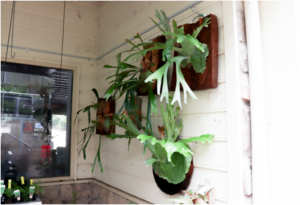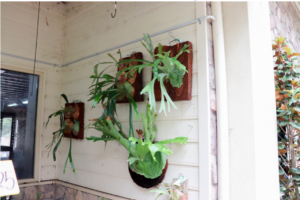What are Staghorn and Elkhorn plants?
Staghorn and Elkhorn plants are both epiphytic ferns in the Platycerium genus, known for their unique and striking appearance. While they share some similarities, there are distinct differences between the two:
- Leaf Shape: One of the primary differences between Staghorn and Elkhorn plants lies in their leaf shape. Staghorn ferns (Platycerium bifurcatum) have fronds that resemble deer antlers or stag horns, with branching, lobed structures. Elkhorn ferns (Platycerium superbum) have fronds that resemble elk or moose antlers, with broad, shield-like leaves that overlap each other.
- Leaf Texture: Staghorn ferns typically have smoother and more elongated fronds with fewer divisions and a leathery texture. Elkhorn ferns, on the other hand, have thicker and more substantial fronds that are somewhat fuzzy or felt-like in texture.
- Growth Habit: Staghorn ferns tend to have a more upright growth habit, with their basal fronds wrapping around a support structure, such as a tree trunk or mount. They are often mounted on plaques or hung in baskets. Elkhorn ferns, however, have a more spreading growth habit, with their fronds fanning out horizontally or slightly drooping.

- Natural Habitat: Staghorn ferns are native to tropical and subtropical regions, including Australia, Indonesia, and the Philippines. They are commonly found growing on trees or rocks in the rainforest canopy. Elkhorn ferns are native to eastern Australia and are typically found in the understory of rainforests and along creek banks.
- Care Requirements: Both staghorn and elkhorn ferns have similar care requirements, but there are some nuances. They prefer bright, indirect light and high humidity levels. Staghorn ferns generally prefer slightly shadier conditions compared to elkhorn ferns, which can tolerate more direct sunlight. Regular misting, proper watering, and providing adequate air circulation are important for their well-being.
- Propagation: Both ferns can be propagated by spores or division. Staghorn ferns can also be propagated by detaching offsets, known as pups, that form at the base of the plant. Elkhorn ferns can produce spores on the undersides of their fertile fronds, which can be collected and used to grow new plants.

Both Staghorn and Elkhorn ferns are prized for their distinctive appearance and are often cultivated as ornamental plants. They can be a beautiful addition to gardens, terrariums, or as indoor houseplants, showcasing their unique shapes and adding a touch of natural elegance to any setting.

